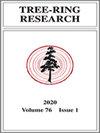Wiggle-Matched Red Cedar from a Pre-Monumental Occupation at Kincaid Mounds, Illinois, USA
IF 1.1
4区 农林科学
Q3 FORESTRY
引用次数: 3
Abstract
ABSTRACT Wiggle-matched 14C dates anchored an 82-year floating cedar tree-ring chronology from the basal layer of a Mississippian Period mound to AD 1170 ± 9 (1σ) (outermost ring). Although numerical cross-matching showed preference for a temporal placement consistent with the 14C dates and visual matching, statistical scores were below critical thresholds for annual crossdating. Sapwood-corrected terminus post quem dates for the material, and their stratigraphic relationship with overlying dates, show that the earliest truncate mound construction at Mound 4 occurred after AD 1177. This date is informative for the timing of the transition of Kincaid to a major regional center and does not support an earlier hypothesis that Mound 4 was constructed in Early Kincaid times (AD 1050–1150). These results demonstrate the potential for archaeological collections to extend long tree-ring chronologies in the Midwestern U.S.美国伊利诺斯州金凯德土丘前纪念性占领中摇摆匹配的红雪松
摘要:Wiggle匹配的14C日期确定了一个82年的浮动雪松年轮年表,从密西西比纪土丘的基底层到公元1170±9(1σ)(最外圈)。尽管数字交叉匹配显示出对与14C日期和视觉匹配一致的时间位置的偏好,但统计得分低于年度交叉匹配的临界阈值。Sapwood校正了该材料的终点后quem日期,以及它们与上覆日期的地层关系,表明4号丘最早的截形土堆建造发生在公元1177年之后。这一日期为金凯德向主要区域中心过渡的时间提供了信息,不支持早期的假设,即丘4建造于金凯德早期(公元1050–1150年)。这些结果表明,考古收藏有可能扩展美国中西部的长年轮年表。
本文章由计算机程序翻译,如有差异,请以英文原文为准。
求助全文
约1分钟内获得全文
求助全文
来源期刊

Tree-Ring Research
农林科学-林学
CiteScore
2.40
自引率
12.50%
发文量
15
审稿时长
>36 weeks
期刊介绍:
Tree-Ring Research (TRR) is devoted to papers dealing with the growth rings of trees and the applications of tree-ring research in a wide variety of fields, including but not limited to archaeology, geology, ecology, hydrology, climatology, forestry, and botany. Papers involving research results, new techniques of data acquisition or analysis, and regional or subject-oriented reviews or syntheses are considered for publication.
Scientific papers usually fall into two main categories. Articles should not exceed 5000 words, or approximately 20 double-spaced typewritten pages, including tables, references, and an abstract of 200 words or fewer. All manuscripts submitted as Articles are reviewed by at least two referees. Research Reports, which are usually reviewed by at least one outside referee, should not exceed 1500 words or include more than two figures. Research Reports address technical developments, describe well-documented but preliminary research results, or present findings for which the Article format is not appropriate. Book or monograph Reviews of 500 words or less are also considered. Other categories of papers are occasionally published. All papers are published only in English. Abstracts of the Articles or Reports may be printed in other languages if supplied by the author(s) with English translations.
 求助内容:
求助内容: 应助结果提醒方式:
应助结果提醒方式:


